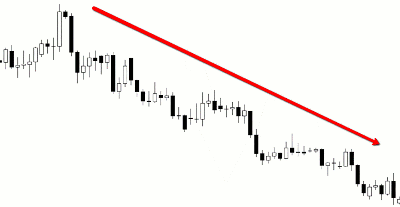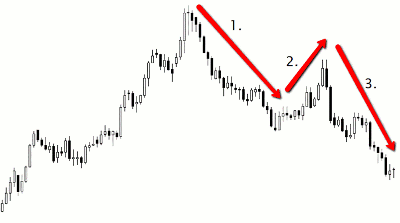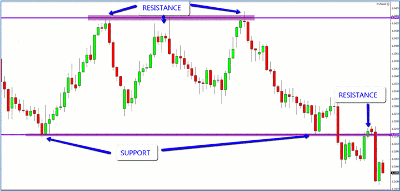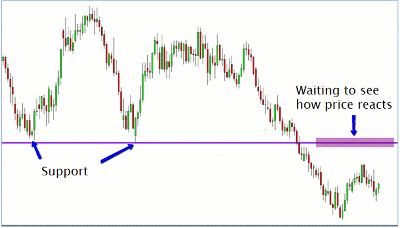The staff at DailyForex.com explains how to find areas of opportunity on most any forex price chart.
To successfully trade price action, a trader must be able to identify if a market is trending or ranging. Once this has been assessed, clear levels of support or resistance must be marked for possible set-ups to trade either long or short.
Identifying the Trend
Technical traders use can use many different tools to identify the trend, including moving averages, however, the best tool the trader has at their disposal is their eyes. After much experience and chart time, a trader begins to get a feel for how a market is unfolding and moving.
When learning to identify trends, it is always best to start on the larger time frames such as the daily charts. These larger time frames hold the key to all the big moves in the market.
The chart below shows a daily chart of the EUR/USD, which can be seen as being in a very obvious downtrend.
Trading with the trend in your favor is always the best course of action. Often you will hear that "The trend is your friend," and this is very true. The reason for this is that the overall trend normally continues until some sort of major support or resistance in the market is hit or a large fundamental change in one of the economies involved occurs.
A pattern in the market that may signal a trend is underway is known as the "1, 2, 3 pattern." This pattern is made up of three legs of price movement. For a bearish trend, the pattern is made up of:
- Price falls lower
- Price retraces and creates a lower high
- Price falls lower again and creates a new lower low
In the chart below, we have an example of this pattern. We can see that price first went lower before then retracing and creating a lower high. The pattern was then confirmed when price went lower and created a lower low.
NEXT: How to Define Support and Resistance Levels
|pagebreak|Marking Support and Resistance
Support and resistance is a very important part of the forex market. Price will often bounce or move away from support or resistance, so learning how to mark these levels correctly is critical.
To mark support and resistance, we need to mark the most obvious levels on the larger-time-frame charts such as the one-day chart. The levels we plot on the daily chart will guide us when trading on the intraday charts such as the four-hour and one-hour.
Below is a chart of the daily EUR/AUD. Only the very clear and obvious levels have been marked. Take note just how closely price respects these areas.
Waiting for Price to Reach Key Levels
Once support and resistance levels have been marked clearly on a chart, the next job of a price action trader is to watch and wait for price to reach these important levels in the market. Price action gives clues all the time as to what direction it is looking to trade in.
Traders should pay particular attention to what price does when it reaches the support and resistance levels and whether price rejects these levels or breaks out. Traders all over the world are watching these levels and watching for trading opportunities.
The following chart shows an example of an area that traders would be watching and waiting for price to reach.
Matching Price Action Set-ups with Support and Resistance
Once traders have worked out the strength and direction of the trend and also identified the key places in the market they would like to enter, they then need to learn to trade the market above and below these key areas.
To successfully trade price action set-ups, traders will need to learn everything about the trading set-ups, including how to enter, how to place stops, and how to correctly manage trades once they are in them.
Putting It All Together
Trading with as many factors in your favor is going to increase the chance of placing a winning trade. Smart traders try to trade with as much confluence as they possibly can.
When looking to trade price action signals, try to trade with:
- The trend in your favor
- From key levels in the market
- Reliable and proven price action signals
Trading price action does not need to be a made complicated. The traders that usually turn out to be the successful price action traders always look to trade with as many market factors in their favor as they can.
By the Staff at DailyForex.com

























